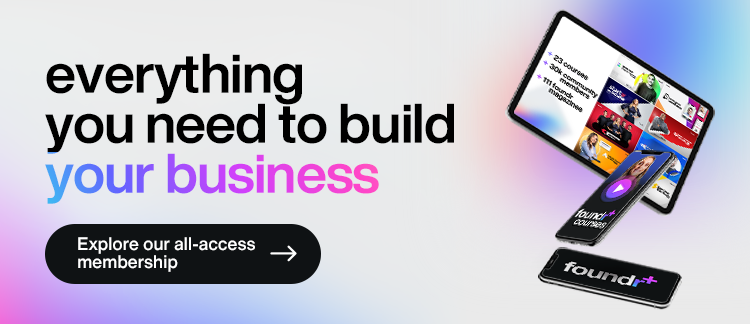When circumstances are right, launching a subscription product can transform your businessl, but it can also take a lot of time, effort, and learning along the way.
I should know, given that we launched our subscription product, foundr+, back in 2022. Creating a subscription product has totally changed how I think about business.
And I can say without doubt it wasn’t an easy process, and certainly one that we continue to work on and tweak to become the best offering it can be.
Here, I want to talk to you about what I’ve learned from building a subscription model and what you can do to ensure your launch is an overwhelming success.
Table of Contents
What Is a Subscription Business Model?
Should You Start a Subscription Business?
Steps to Start a Subscription Business
How You Know a Subscription Model Is Successful?
Advice From Those Who’ve Done It
What Is a Subscription Business Model?
A subscription business model focuses on getting customers to register for a monthly or annual payment, in turn providing those customers with continued service.
Subscription business models are common in the fitness industry for gym companies and ecommerce brands, such as collectible loot boxes and monthly alcohol or food subscriptions.
Often, the most successful subscription businesses are for products that are perishable and need to be replaced on a regular basis, like razor blades or services that add continuous value.
Take Apple or other streaming services, for example. If they didn’t continue to add new shows and films and publish their own content, they would struggle to retain such a high volume of monthly subscribers, as once you had watched everything you wanted, why would you keep paying?
It’s why Disney or Paramount have struggled to find continued success in the industry, as there are many who feel that they do not create enough new or quality content to justify paying for it every week.
Have you watched any of the recent Marvel shows? Point proven.
Gym companies also adopt a subscription model, as, sadly, you can’t spend a month going hard and have a perfect body for the rest of your life. Fitness and muscles need to be worked on consistently, which makes the industry ideal for a subscription service.
Should You Start a Subscription Business?
So, is a subscription business right for you? A subscription model can be incredibly successful, but only if your business ticks the right boxes.
What industry are you in?
First, take a step back and look at the industry you are planning to set up within or are already operating in.
What are your competitors doing? Have any competitors tried a subscription model and moved away from it?
These are all telltale signs of whether or not a subscription model is the right option or not. On the flip side, it may highlight a gap that your competitors have missed, where you can provide a subscription model that will differentiate you from other brands.
Do you have the infrastructure?
Secondly, consider whether or not you have the infrastructure in place to facilitate a subscription model.
For example, if you are planning a product-based subscription, do you have (or have access to) the necessary stock to fulfill everybody’s monthly orders, assuming you get plenty of subscribers?
Equally, if your service works on a unique offering where a subscriber gets a particular product in month one, then month two, and so on, you need a system in place to track who has been sent what to ensure their journey is smooth and as expected.
What additional value will you provide?
Finally, you must have an honest conversation with yourself about what additional value you will offer those who subscribe. At face value, subscriptions seem like a magical solution to monthly or annual revenue for your business, but it must naturally benefit the customer, not just your financial planning.
Potential subscribers are spoilt for choice when it comes to investing in subscriptions, and with so much free content available today, you must make sure that your subscription offers something truly unique that is of a higher standard than the regular free content.
Don’t Skip: Ecommerce Business Ideas That Yield Powerful Results
Steps to Start a Subscription Business
Once you have answered the questions laid out above, it’s time to get started setting up your new subscription model.
Follow this step-by-step guide to get yourself going on the right track.
Step 1: Who’s it for?
Before you start working away, feverishly building an infrastructure that would make Netflix envious, you need to consider your target audience.
What are their pain points? What do they want to see from a subscription service?
It’s all well and good for building a wonderful user interface and offering, but if you’re trying to sell something to an audience that doesn’t want it, you’re going to struggle.
If you already have a loyal community in place, you could lean on them for ideas and inspiration. Not only will this help you create a service that suits them, but it will also make them feel valued and involved, which will make them more likely to subscribe.
Step 2: Do your research
Next, it’s time to conduct some market research, analyzing any competitor’s offerings and identifying what they do well and what they could do better. This process will also help inspire your offering and help you establish what the going rate is for a subscription in your chosen industry.
Step 3: Identify your USP
Now that you’ve got a ton of information on what your competitors offer, it’s time to work out how you plan to stand out from the crowd.
Through a combination of customer pain points and weaknesses in competitor subscriptions, you will be able to identify your unique selling position and attract a larger audience.
A great example of this was when PureGym launched in the UK back in 2009. They assessed all of the UK gym subscriptions and found that many people wanted a cheaper gym option and had never used the spas and swimming pools on offer at the current gyms on the market.
So PureGym created a 24/7 gym service that was budget-friendly and cut all the trimmings. In the 15 years that have followed, the company has gone on to be the largest gym company in the UK while also expanding into other countries.
Step 4: Source or develop your offering
If your subscription service is based on offering physical products, then it is a non-negotiable that you set up with reliable suppliers. That way, as you continue to scale your offering, you can be confident that you have the infrastructure in place to ensure supply keeps up with demand.
If you are providing a service or digital content, you must provide ongoing value and offer something that stands out from the free content available online. Trust me, unlike a traditional product launch, the work only ramps up after you’ve launched a subscription.
Step 5: Sort out the back end
Before launching your subscription model, it’s important to know it makes financial sense. That means estimating the setup and ongoing costs and working out what you should price it at based on market research and what will make you a healthy profit.
Step 6: Create high-value free content
Before anyone invests in your paid content, you’ll need to show them that you’re the real deal. Unless you already have an established brand, you’ll need to show potential customers that you know your stuff, and your free content needs to reflect what they can expect from subscribing to your services.
Build interest through blog content, social media, and other marketing channels to expand your reach and drum up interest.
Step 7: Invest in customer support
When people spend money on a service, they expect a certain level of support. In fact, consumer expectations are at an all-time high, so it’s crucial that your customer support system is set up to handle any inquiries or issues quickly and effectively.
Communication must be clear, transparent, and on brand. Don’t be afraid to show some personality when responding to queries on social media, and always ensure that you put your customers first.
Step 8: Test and learn
Once your subscription is set up, your work is not done. It is absolutely essential that you continue to test and learn, take customer feedback into consideration, and consider to ensure that your subscription is valuable and relevant.
For example, last year, we heard feedback from foundr+ members that they wanted help using AI for ecommerce. So, we recently invested in our brand-new course on how to use AI to grow your business.
How You Know a Subscription Model Is Successful?
Ultimately, it won’t be difficult to see whether or not your subscription is successful. Initially, success will be determined by the number of sign-ups and the monthly revenue figures.
However, as these numbers increase, success should shift to also focus on customer retention figures, establishing how long people subscribe to your service.
For example, if you are getting a large chunk of people subscribing only to cancel a month later, that sort of service is not sustainable.
With subscription models, the focus must be on longevity, as that is where the real money can be made.
Keep Learning: How to Come Up with New Product Ideas (That Don’t Suck)
Advice From Those Who’ve Done It
But don’t just take our word for it. Here’s some advice from our interviews with subscription-based business founders who have walked the steps that are laid out in front of you.
Jessica Rolph Lovevery: Founder of Happy Family & Lovevery
“Obsess over your product and really do a ton of testing and research before you launch,” she says. “And then after you launch, remember that your product is not done; that actually launching the product is a continuation of the product development process. That’s where you start getting feedback at scale and continue obsessing over that feedback and iterating your product. Never be satisfied with what you have. Always be looking to make it better.”
Learn More: Jessica Rolph Says Your Subscription Product Needs Purpose.
Suneera Madhani: Founder of Stax Payments
“I encourage founders to leverage any white-label solutions that are already there to get an MVP off the ground,” Madhani says. For example, she partnered with a banking institution to white label a transaction software to test the hypothesis of a subscription-style model versus a percentage-style model.”
Read the rest of our feature on Madhani.
Lynda Weinman: Founder of Lynda.com
“Of course, you’re going to stop subscribing,” Weinman says. “And it isn’t necessarily a reflection of the bad product that’s being offered. It’s a reflection of the fact that the user might have some different goal in mind.”
Read the rest of our feature on Weinman.
Michael Dubin: Founder of Dollar Shave Club
“A lot of people get addicted to this notion of a subscription business because they love the idea of monthly recurring revenue, but you should only be launching a subscription business if it’s going to be an enhancement to…the customer’s experience. The customer’s experience is the most important thing. If delivering them a subscription is going to make their life better or happier, you should offer a subscription. And if not, you shouldn’t.”
Read the rest of our feature on Dubin.
Tobi Pearce: Founder of Sweat App
“Subscription business economics are completely and fundamentally different to that of a traditional ecommerce business. As with any subscription business, churn is always a concern. One way to combat the tendency for members to cancel their subscriptions is to cultivate an engaged community.”
Read the rest of our feature on Pearce.
Get Ahead of the Competition
Try out our subscription foundr+, to get complete access to the training, coaching, and community you need to build your business.
Work with world-class instructors and learn from proven frameworks to help your business take off. Sign up today and join foundr+.
The post Building a Subscription Business Model: How to Stand Out in a Saturated Market appeared first on Foundr.




